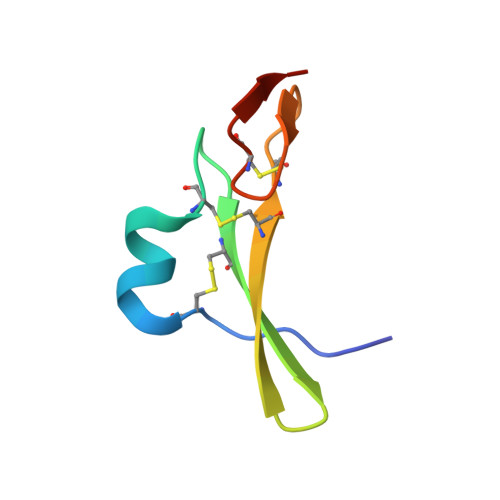Structural basis for EGFR ligand sequestration by Argos.
Klein, D.E., Stayrook, S.E., Shi, F., Narayan, K., Lemmon, M.A.(2008) Nature 453: 1271-1275
- PubMed: 18500331
- DOI: https://doi.org/10.1038/nature06978
- Primary Citation of Related Structures:
3C9A, 3CA7, 3CGU - PubMed Abstract:
Members of the epidermal growth factor receptor (EGFR) or ErbB/HER family and their activating ligands are essential regulators of diverse developmental processes. Inappropriate activation of these receptors is a key feature of many human cancers, and its reversal is an important clinical goal. A natural secreted antagonist of EGFR signalling, called Argos, was identified in Drosophila. We showed previously that Argos functions by directly binding (and sequestering) growth factor ligands that activate EGFR. Here we describe the 1.6-A resolution crystal structure of Argos bound to an EGFR ligand. Contrary to expectations, Argos contains no EGF-like domain. Instead, a trio of closely related domains (resembling a three-finger toxin fold) form a clamp-like structure around the bound EGF ligand. Although structurally unrelated to the receptor, Argos mimics EGFR by using a bipartite binding surface to entrap EGF. The individual Argos domains share unexpected structural similarities with the extracellular ligand-binding regions of transforming growth factor-beta family receptors. The three-domain clamp of Argos also resembles the urokinase-type plasminogen activator (uPA) receptor, which uses a similar mechanism to engulf the EGF-like module of uPA. Our results indicate that undiscovered mammalian counterparts of Argos may exist among other poorly characterized structural homologues. In addition, the structures presented here define requirements for the design of artificial EGF-sequestering proteins that would be valuable anti-cancer therapeutics.
- Department of Biochemistry and Biophysics, University of Pennsylvania School of Medicine, 809C Stellar-Chance Laboratories, 422 Curie Boulevard, Philadelphia, Pennsylvania 19104-6059, USA.
Organizational Affiliation:
















